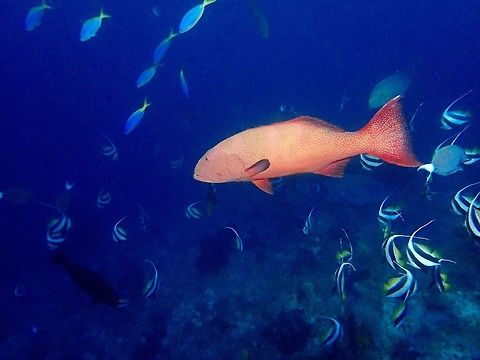
Distribution
The Coral trout is found in the waters around American Samoa, Australia, Brunei, Cocos Islands, Fiji, Hong Kong, Indonesia, Japan, Malaysia, Micronesia, New Caledonia, Northern Mariana Islands, Palau, Papua New Guinea, the Philippines, Samoa, Singapore, Solomon Islands, Taiwan, Thailand, Vietnam, Saudi Arabia, and Egypt. Its natural habitat includes open seas and coral reefs. Studies suggest that coral trout move around considerably within a single reef, though often no further than 500 meters from it. Movement between neighbouring reefs does not occur to a large extent; however, there have been a few cases where fish have moved from one reef to another. Much of this movement may be the result of fish moving towards or away from spawning sites.Habitat
The Coral trout is found in the waters around American Samoa, Australia, Brunei, Cocos Islands, Fiji, Hong Kong, Indonesia, Japan, Malaysia, Micronesia, New Caledonia, Northern Mariana Islands, Palau, Papua New Guinea, the Philippines, Samoa, Singapore, Solomon Islands, Taiwan, Thailand, Vietnam, Saudi Arabia, and Egypt. Its natural habitat includes open seas and coral reefs. Studies suggest that coral trout move around considerably within a single reef, though often no further than 500 meters from it. Movement between neighbouring reefs does not occur to a large extent; however, there have been a few cases where fish have moved from one reef to another. Much of this movement may be the result of fish moving towards or away from spawning sites.Reproduction
Documenting the size and age structures during reproduction of coral trout stocks have been a focus of the ELF Experiment as a major indication of how fish stocks respond to various levels of fishing pressure.Coral trout are protogynous hermaphrodites. They start their lives as females and change sex later in life. The trigger of this sex change is unknown. On average, sex change occurs when fish are between 23 centimetres and 62 cm in length; the average length at sex change is 42 centimetres. This is believed to happen most frequently in the months immediately following spawning.
ELF research has determined that the sex ratio differs in different areas of the Great Barrier Reef, and may differ between reefs opened and protected from fishing. Sex ratios are an important consideration for management, as changes could seriously affect reproduction and thus the number of juveniles coming into the fishery in future years. All length classes of fish may have both male and female individuals. However, small fish are generally females, while most large fish are males.Like most reef fish, coral trout have a larval stage where the eggs and larvae develop within the water column, allowing them to disperse to nearby reefs.
Fertilisation takes place after spawning; the fertilised eggs float just below the water surface. The incubation period for coral trout eggs is unknown, but may be around 20 to 45 hours. The newly hatched larvae are not very well developed and obtain nutrients from a yolk sac. As the develop, their spines, fins, gut, and other internal organs develop, as do their senses. Eventually, the yolk sac is completely absorbed and the larvae begin to see and catch their own prey.
Food
Coral trout are piscivores. Younger juvenile trout mostly eat crustaceans, especially prawns which live on or near the reef bottom. However, adults feed upon a variety of reef fish. The most common type of fish eaten is damselfish, particularly the spiny chromis damselfish. Adult coral trout also eat juveniles of their own species. Individual coral trout usually feed once every 1–3 days, although they may go for many days without feeding. 90% of a prey item will be digested within 24 hours. Coral trout only feed during daylight hours, most often at dusk and dawn.Coral trout hunt in two different ways: by ambush and by prowling. They use the ambush method to hunt fish that live among the coral on the reef bottom. The trout will hide and remain very still and alert, ready to attack passing prey. The prowling method is used to hunt schooling fish higher up in the water. Here, the trout will move slowly towards the prey and attack at great speed.
Individual coral trout have different feeding behaviours, possibly explaining the variability in growth and maturity.
Studies have shown that coral trout in the southern Great Barrier Reef feed mainly on parrot fish and hardyhead bait fish. The most common prey items further north are the damselfish and fusiliers or banana fish. One study showed coral trout eating schools of fusilers in summer, and scarids during the winter months. This seasonal variation is quite common in the diet of coral trout due to varying abundances of prey at different times of the year. Trout also tend to eat more food in winter, possibly to increase fat stores in preparation for reproduction in spring.
Harvest
Queensland, Australia has a significant coral trout fishery. Fishermen catch the trout using hand lines and pilchards for bait, operating from small dories or runabouts throughout the day then returning to a mother ship where the catch is kept live in bio tanks until the return to Port after several days working at sea.
References:
Some text fragments are auto parsed from Wikipedia.